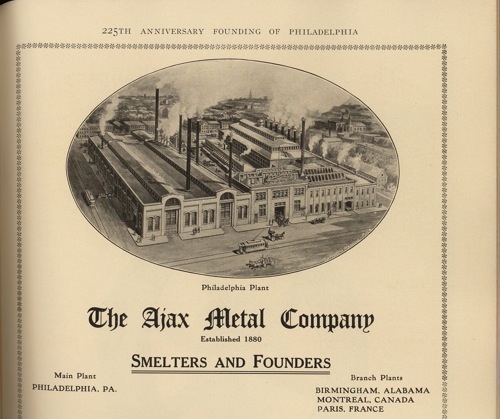
Ajax Metal Company, 1893-1944
1000-1052 Frankford Avenue, Philadelphia PA 19123
© Stuart Paul Dixon,
Workshop of the
World (Oliver Evans Press, 1990).
Fishtown's industrial
heritage includes several metalworking and
metal-fabrication establishments that date to the
mid-nineteenth and early twentieth centuries. One vestige
of the recent past is the Ajax Metal Company complex at
1000-1052 Frankford Avenue. Consisting of four buildings
constructed between 1893 and 1944, this complex, once
devoted to the smelting and refining of metals, embraces
the entire block bounded by Frankford Avenue to the east,
Richmond Street to the north, Allen Street to the south,
and Interstate 95 to the west. In 1950 Ajax sold the site
to its present owner.
The company's two-story office, five bays wide on the
first story, is at 46 Richmond Street; it was erected in
1907 of reinforced concrete and brick curtain walls. Rear
wings that extend to Allen Street contained crucibles, a
core storage room, and a shipping and receiving
department.
Facing Richmond Street, a one-story, 10-bay brick foundry
with two four-foot frame round-arch monitors extends
south along Frankford Avenue for 22 bays. Constructed in
1893, the foundry by 1950 contained an electric furnace
department and air compressors. The faded outline of
letters forming "Ajax Metal Company" remains in the brick
cornice above a truck-loading bay.
The "Ajax Electric Co., Inc" Warehouse and Plant No. 1,
identified in Sanborn Insurance Survey maps, stands at
the corner of Allen Street and Frankford Avenue and
extends 10 bays north along Frankford. Built in 1931,
this two-story steel frame structure is faced in brick
and has exterior pilasters and art deco-styled capitals
that define window and door bays. A two-story, three-bay
brick office and warehouse built in 1944 at 42 Richmond
Street completes the Ajax complex. Brick curtain walls
surround a steel and concrete frame, which supports a
concrete roof. A rear addition contains a foundry;
another rear addition that fronts on Allen Street
consists of a four-story brick building that houses a
receiving department on the first floor and furnace
storage and laboratory rooms on the upper stories.
This part of Fishtown has long been associated with metal
fabrication. In the mid-nineteenth century, before
creating a huge industrial complex in Tacony, Henry Disston &
Sons was located in this area.
The Nicholson File Company manufactured metal files
throughout the early 1900s in the block immediately
north of Ajax. By 1893, the Ajax Brass Metal Works had
erected the double-monitored foundry that currently
forms part of the Ajax Metal complex on Frankford
Avenue.
A 1900 city directory lists Ajax as manufacturers of
"Ajax Metal," probably a lead-coated sheet metal, since
the Ajax Lead Coating Company appears at the site the
same year. Ajax continued smelting brass, tin, copper,
lead, zinc, and antimony alloys throughout the early
1900s. The company also produced "Plastic Bronze," an
alloy for high-grade machinery bearings; "Manganese
Bronze," used by automobile manufacturers; and "Bull
Babbitt," a soft, silvery, antifriction alloy. By 1908,
Ajax had become an international conglomerate with branch
offices in Montreal and Paris. In 1936, it introduced the
Ajax-Hultgren Salt Bath Furnace. By 1941, the corporate
entity became Ajax Electric Company; its subsidiary firms
were Ajax Metal, Ajax Electric Furnace Company, and the
Ajax Electrothermic Corporation.
Ajax Metal had an office staff of 27 in 1916 and employed
180 men and 6 women. The company grew, diversified, and
served a vital role in Fishtown's economy until 1950. Its
old buildings now serve as warehouses.
Update May
2007 (by
Torben Jenk):
Vacant.